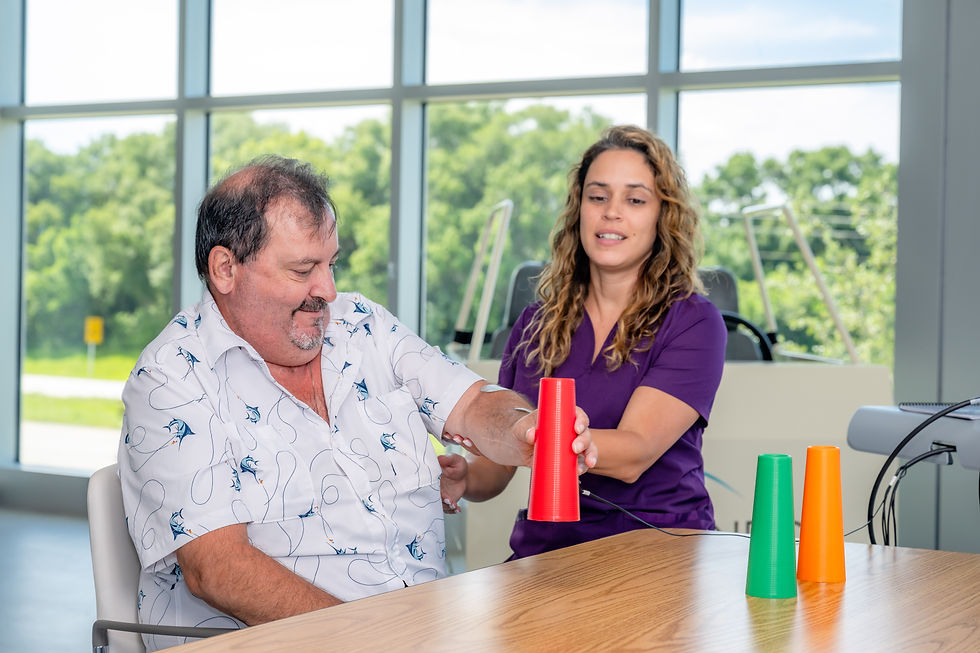World Physical Therapy Day: Moving Toward Better Health
- Cincinnati Rehabilitation Hospital
- Sep 1
- 4 min read
Updated: Sep 5

On World Physical Therapy Day, we take time to recognize the science, skill, and compassion behind a profession that helps millions of people reclaim their mobility, independence, and quality of life. From restoring movement after surgery to supporting rehabilitation after a disabling disease or injury, physical therapy has an incredible ability to transform lives.
Physical therapy is far more than a set of exercises. It is a personalized approach to healing that combines medical knowledge, hands-on care, and patient and caregiver education. Whether someone is recovering from a stroke, adjusting to life after a joint replacement, or recovering from a brain injury, physical therapy helps people regain function and improve overall well-being.
The Role of Physical Therapy in Health and Functional Improvement
At its core, physical therapy is about helping the body heal, adapt, and function. A licensed physical therapist works with each patient to understand their condition, design a personalized plan of care, and guide them through safe, progressive exercises. But the benefits go beyond physical movement. Patients often experience reduced pain, improved confidence, and a better understanding of how to function, move safely, and care for their bodies in the long run with planned physical therapy treatments.
Physical therapy in medical rehabilitation is focused on:
Functional improvement after surgery or a disabling condition
Fall prevention and balance improvement
Pain management techniques with a goal to reduce pain medications
Prevention of future injuries
By focusing on long-term function rather than short-term fixes, physical therapy empowers people to lead more active, independent lives.
The Power of Physical Therapy
For older adults, physical therapy can mean maintaining independence for years longer by improving balance and reducing the risk of falls. While much of physical treatment in rehabilitation is focused on function and mobility improvements, it is also a powerful tool for prevention. Many people seek physical therapy before an injury occurs or surgery is scheduled, using it to improve posture, strengthen core muscles, and correct movement patterns. This proactive approach can significantly reduce the risk of falls, strains, sprains, and other injuries.
Physical Therapy Working Hand in Hand with Occupational Therapy

While physical therapy focuses on improving movement and function, occupational therapy helps people adapt those improvements to everyday activities. This can be especially valuable after a significant injury or surgery, when the goal is not just to walk or lift again, but to return to meaningful daily routines. Both physical and occupational therapies are often warranted in rehabilitation treatment plans.
For example, someone recovering from a hip injury might work with a physical therapist to rebuild strength and balance. At the same time, an occupational therapist could help the individual practice getting in and out of a car, cooking safely, or performing work-related tasks without discomfort.
The two disciplines collaborate on the treatment plan for a complete, well-rounded approach to medical rehabilitation for the best outcomes.
Life After an Orthopedic Injury
An orthopedic injury, such as a hip fracture, a torn ligament, or even joint replacement surgery, can affect overall mobility and high-quality living. The initial pain and swelling are only part of the challenge; the real work begins during recovery when the body needs to rebuild strength, flexibility, and coordination. A hip fracture program can make the difference between returning to an active lifestyle and facing long-term mobility challenges. For older adults, hip fractures can be life-altering, affecting confidence, independence, and quality of life.
Physical therapy after a hip fracture focuses on restoring mobility through safe walking exercises, balance training, and lower body strengthening. These targeted activities not only help patients get back on their feet but also reduce the risk of future falls, one of the most common causes of re-injury.
By working closely with a therapist, patients also gain practical strategies for navigating daily life safely, from climbing stairs to moving around the kitchen.
Physical therapy plays a critical role in this process. By addressing muscle imbalances and teaching proper movement techniques, it supports long-term joint health and reduces the likelihood of re-injury.
Back Surgery Rehabilitation

Back surgery can be life-changing, offering relief from severe pain or improving spinal function. But the road to recovery does not end in the operating room. It continues through structured, supervised movement. Too often, individuals live with pain or limited mobility because they believe nothing can be done.
Back surgery rehabilitation through physical therapy focuses on gradually restoring spinal mobility, strengthening the surrounding muscles, and retraining posture. In the initial stages, exercises are gentle and designed to protect healing tissues. As recovery progresses, patients move on to more challenging activities that prepare them for everyday movement, such as bending, lifting, and walking.
A key benefit of this process is education. Patients learn how to move safely, avoid strain, and maintain back health for the long term. This kind of proactive care helps preserve surgical results and reduces the chance of future spine problems.
Why World Physical Therapy Day Matters
World Physical Therapy Day is not just about celebrating a profession. It is about raising awareness of the vital role that physical therapy plays in rehabilitation, let alone in many stages of life. Learn more about our physical therapy team and rehabilitation treatments or arrange a tour by contacting us today.









